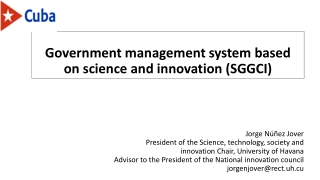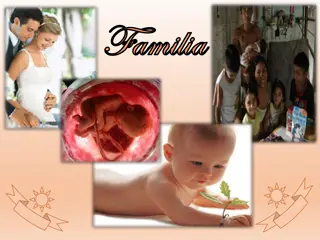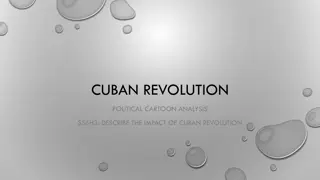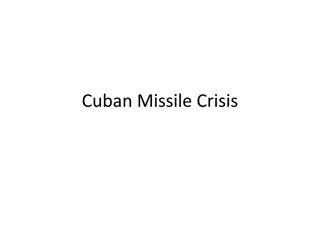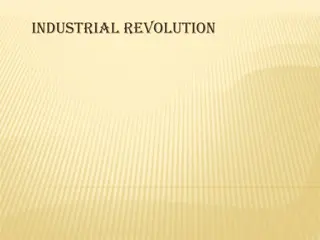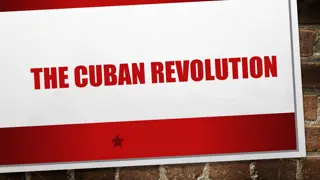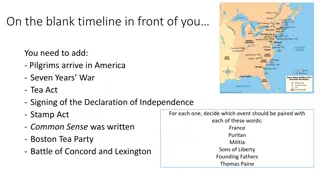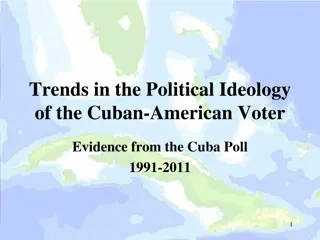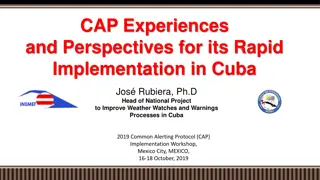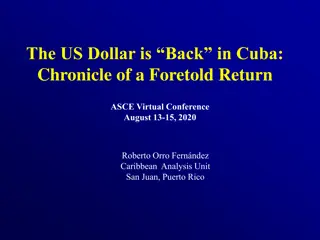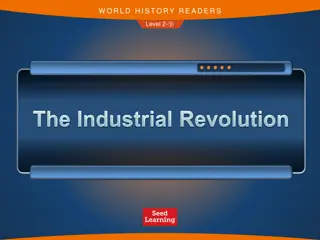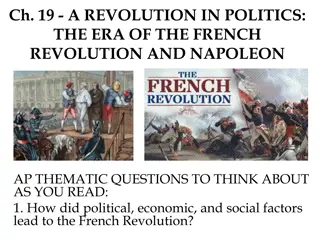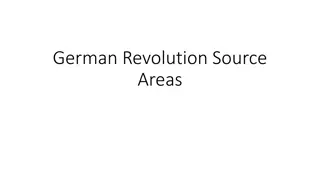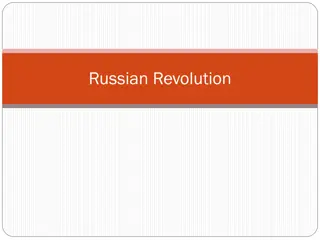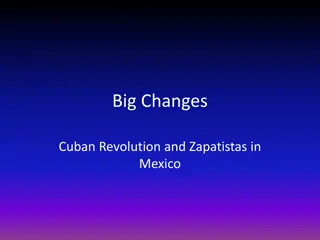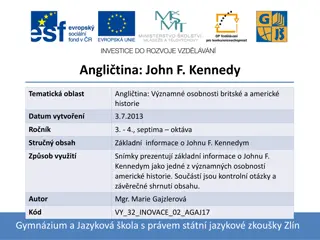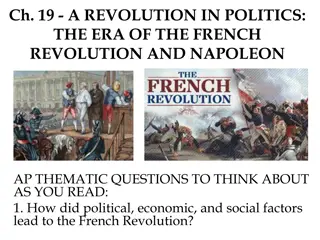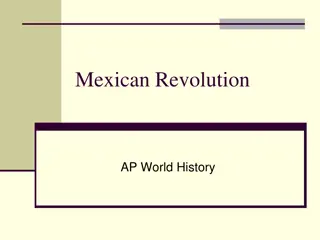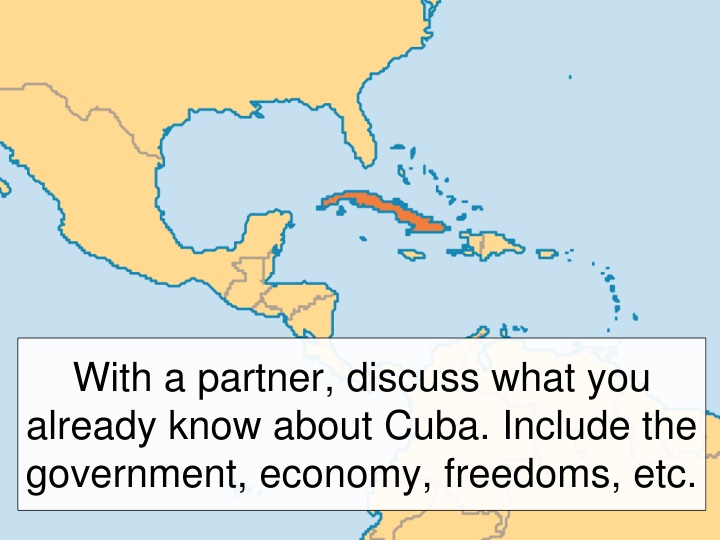
Exploring the Impact of the Cuban Revolution
Discover the influence of the Cuban Revolution on Cuba's government, economy, and freedoms, while delving into its historical context and lasting effects. Uncover Cuba's rich natural resources and its struggle for independence. Gain insights into Spain and Portugal's colonization of Latin America, the fight for freedom in various Latin American countries, and how the U.S. intervened in Cuba.
Download Presentation

Please find below an Image/Link to download the presentation.
The content on the website is provided AS IS for your information and personal use only. It may not be sold, licensed, or shared on other websites without obtaining consent from the author. If you encounter any issues during the download, it is possible that the publisher has removed the file from their server.
You are allowed to download the files provided on this website for personal or commercial use, subject to the condition that they are used lawfully. All files are the property of their respective owners.
The content on the website is provided AS IS for your information and personal use only. It may not be sold, licensed, or shared on other websites without obtaining consent from the author.
E N D
Presentation Transcript
With a partner, discuss what you already know about Cuba. Include the government, economy, freedoms, etc.
In this lesson, we are going to examine a specific event that has had a lasting affect on the country of Cuba.
Essential Question: How did the Cuban Revolution impact Cuba?
Standard: SS6H3a. Explain the impact of the Cuban Revolution.
Lets review what we have learned so far
By the 15thcentury, European exploration and colonization was underway.
Spain and Portugal set up empires in Latin America.
By the mid 19thcentury, most Latin American countries had achieved independence from Spain and Portugal. Haiti: Toussaint L Ouverture Mexico: Miguel Hidalgo Venezuela, Colombia, Peru, etc: Sim n Bol var Brazil also gained independence from Portugal
This is where we begin
By the late 19thcentury, there were only two Spanish colonies left in the Americas. Cuba Puerto Rico
What can you remember about Cubas natural resources? Cuba has rich soil which is good for growing sugarcane, coffee beans, tobacco, and other crops. Sugar is Cuba s most important product.
At the end of the 19thcentury, the U.S. declared war on Spain to help the people gain freedom from Spanish rule and to protect sugarcane plantations owned by American businesses.
The U.S. won the war, and Spain gave up Cuba and Puerto Rico. Cuba Puerto Rico
Puerto Rico became a U.S. territory. Cuba became independent, but stayed under U.S. control for many years. Cuba Puerto Rico
For the next 50 years, Cuba had many leaders (some elected, some dictators). The country was very wealthy, but most of the people were extremely poor. Cuba
Whats a dictator? A ruler with total power over a country, typically one who has obtained power by force
With a partner, summarize the important events before the Cuban Revolution on your graphic organizer.
Cuba gained independence when the U.S. fought a war with Spain to gain Cuba s freedom and protect U.S. sugarcane plantations. Cuba had many leaders over the years following their independence. Some leaders were elected and some leaders were dictators.
Why do revolutions occur?
Which group was exploited (taken advantage of) in Cuba? The poor were taken advantage of in Cuba and were angry with their government.
Fidel Just like in other Latin American countries, a leader emerged to take up the cause Castro
In the late 1950s, Fidel Castro led an army of rebels and defeated the corrupt government (a dictator named Batista). This is known as the Cuban Revolution.
With a partner, summarize the causes of the Cuban Revolution on your graphic organizer.
Even though the country was very wealthy, most of the people were extremely poor. Unhappy Cubans were continually angry with their government. In the late 1950s, Fidel Castro led a group of rebels and defeated the corrupt government. He took over and set up a communist government.
Fidel Castro immediately set up a communist government. What is communism?
Communism is a political and economic system in which the major productive resources in a society are owned by the public or the state, and wealth is divided among citizens equally or according to individual need.
Where does communism fall on the economic continuum? Toward Command Economy
How is power distributed in communism? Unitary
World Revolution For Students Castro and the Cuban Revolution Part I [15:03]
Use your graphic organizer to record the impact of the Cuban Revolution
Impact on Cubas Government In reality, Cuba just went from one dictator to another Castro set up a communist government like its ally (supporter), the Soviet Union, and controlled all aspects of the government
How do you think Cuba s economy was affected by the Cuban Revolution?
Impact on Cubas Economy Castro set up a communist government which controlled all parts of the economy He took over farms and businesses, even those owned by the U.S.
Impact on Cubas Economy The Soviet Union was a key ally and trading partner, but when they broke apart, Cuba s economy suffered and still struggles today Food shortages occur from time to time
How do you think Cuba s citizens were affected by the Cuban Revolution?
Impact on Cubas Citizens Many poor people supported Castro s policies because he improved their healthcare and education Successful Cubans such as business owners, teachers, doctors, and others did not like their property being taken.
Impact on Cubas Citizens Due to Castro s communist policies, many successful Cubans left (many went to Florida) People who opposed Castrol were killed or put in prison He controlled everything on the radio, TV, and newspapers.
How do you think the Cuban Revolution affected Cuba s relationship with the U.S.?
Impact on U.S. and Cuban Relations Castro came to power during the Cold War and sided with the Soviet Union causing hostilities Castro took over American businesses without giving compensation (costs) to owners The U.S. imposed an embargo on exports except for food and medicine to Cuba in 1960 and cut off all ties with Cuba in 1961
With an elbow partner, discuss the following: Was the Cuban Revolution good or bad for Cuba? Why?
In 2008, Ral Castro, Fidel Castros brother, replaced Fidel when he became too ill to lead the country. Cuba s government structure remains the same, but Ra l has opened the economy in some ways.
Inside Cuba 1 of 2 BBC Our World Documentary [10:28] Inside Cuba 2 of 2 BBC Our World Documentary [10:57]
Which group benefited the most from the Cuban Revolution? Why? The poor because they gained education, healthcare, and more equal treatment
Which group benefited the least from the Cuban Revolution? Why? The wealthy, land owners, and business owners because Castro took their property for the state
Summarizer Identify a few impacts of the Cuban Revolution

